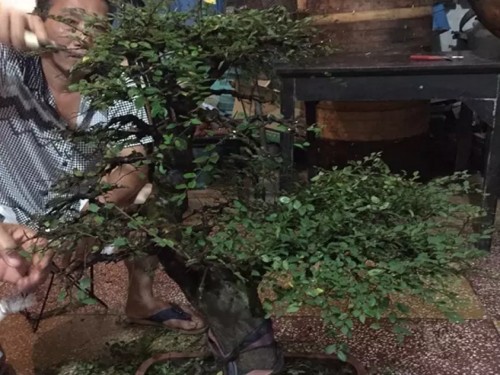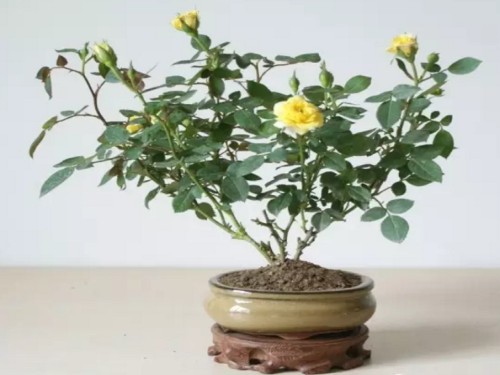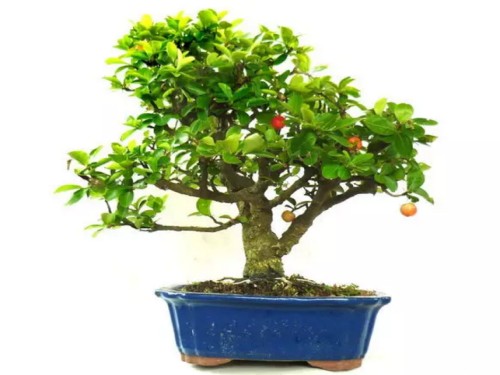How to trim tree stump bonsai
Tree stump bonsai is a kind of living work of art that plants old woody plants are planted in a basin, after years of pruning, binding, fertilization and other artistic processing, fine management, so that the trunk is vigorous and powerful, branches and leaves luxuriant. It will not be shaped because of the first artificial modeling, but continue to grow and change according to the laws of nature. therefore, the usual maintenance management is very important.
Tree stump bonsai is often made of woody plants, selecting plants with graceful posture, short plants, small leaves, long life, pruning resistance, strong resistance and easy modeling to restrain their growth without violating the tree growth habits, picking leaves, picking hearts and so on. and carry on the modeling processing. In the process of cultivating this kind of bonsai, the producer can process it into a variety of artistic shapes, such as intertwined or vigorous, straight and straight, according to his own intention. The maintenance of tree stump bonsai mainly includes watering, fertilization, pruning, changing soil and preventing diseases and insect pests.

The fertilizer and soil of the stump bonsai are similar to those of potted flowers and trees, and pruning is particularly important. Bonsai, which has been formed, must be divided into different tree species, and measures such as coring, pruning, thinning, wiping buds and picking leaves must be taken to make it maintain a wonderful posture.
Especially for some pile scenes with plastic branches, new branches often emerge during the growing period. These prominent branches should be cut off in time to keep the branches flat and clear. Tree species with strong sprouting power, such as sparrow plum and elm, should be trimmed five times a year, while sparrow pine, yew and other tree species grow slowly and branch weakly, so they can be pruned once in June and October respectively.
Black pine, five-needle pine, Huangshan pine, golden pine and other pine bonsai, if you want to make its branches short and dense, you should erase all the main buds on the branches in April, and then the branches will be shorter, and then thinning the branches that are too dense. Pile scenes such as elm and sparrow plum are easy to produce adventitious buds on stems and branches, which should be removed at any time to avoid sprouting branches and affecting the beauty of the tree. Green maple, yellow poplar, bone structure and other tree species, after germination, leave 1 color 2 sections to pick the heart, send and pick again, so that the branches are dense and short, without losing the proportion.
The flowering and fruit appreciation tree species should be pruned according to their flowering and fruiting habits, such as Pyracantha and Begonia, which are mostly on the short branches near the main branches, so the vegetative long branches can be properly cut to produce fruit branches, and at the same time, the inherent flowers and fruits can be fully displayed. Plum blossoms and spring primroses are strongly cut after flowering to promote the germination of strong new branches and blossom in the coming year. Winter is the best pruning period for deciduous tree species, which should be carefully pruned, such as sagging weak branches, disorderly branches, cross branches, overlapping branches and so on, so as to make the crown dense, hierarchical and orderly.
In short, the stump bonsai needs long-term maintenance, careful observation and patient pruning in order to cultivate a beautiful tree shape.
A pot of bonsai stumps with good natural conditions or good natural conditions often grow many new branches. in order to maintain its perfect posture, the bonsai must be often trimmed, otherwise it will gradually lose its hierarchy, resulting in disproportion and tree disorder.
1. Prune the useless branches in time
In general, all cross branches, parallel branches, wheel branches (that is, some four-sided whorled branches of the trunk) and all branches that hinder beauty should be cut off at any time, which can not only maintain the original posture of bonsai, but also help to mediate the reasonable supply of water and nutrients, so that bonsai flowers and fruits bloom year after year.
2. Pruning of broad-leaved tree species
In general, broad-leaf species such as hammer elm, Finch plum, firethorn and other tree species have strong germination. If they are allowed to grow naturally after modeling, many new shoots will appear at the top of the crown, and they should be cut flat and trimmed at any time, so that the original level and posture of bonsai can be maintained. This kind of heart-picking work needs to be carried out 3 or 4 times a year. The lateral buds and adventitious buds on the tillers, branches and trunk should be cut off or erased in time after germination.
3. Pruning of coniferous species
For coniferous species such as Pinus elliottii, Pinus elliottii and Pinus taiwanensis, it is mainly through truncation and sprouting to control the elongation and growth of branches and prevent the foliage from being too dense. After the terminal bud germinates, the new shoots generally grow very fast, often protruding beyond the root crown, so that the tree shape is destroyed. Therefore, in April every year, the main buds on the side branches are removed by hand or all are wiped off; after two weeks, 2 or 5 accessory buds can sprout at the same time where the terminal buds are erased, which disperse the nutrients in the body and grow weakly, so they can maintain a neat and dense crown. The biennial lateral branches should also be properly cut so that several new buds can sprout near the shearing mouth at the same time, which can not only maintain the original level of the crown, but also create a rich, round and natural tree shape.
4. Pruning bonsai for viewing flowers and fruits
Before pruning, we must first master the flowering and fruiting habits of the tree species. All tree species that bloom on short branches should be re-cut to promote axillary buds to sprout and form short branches; tree species that differentiate flower buds from terminal buds should not be truncated to avoid cutting off flower buds; for tree species that bloom in early spring, the flower buds on the branches are differentiated last year, so they cannot be cut short in spring, and the correct pruning time should be placed after the flowers. Such as: spring, rose, poinsettia, pomegranate, kumquat, crape myrtle, etc. bloom on the branches of the same year, so these bonsai should be heavy-cut in the dormant period, which can increase the flowering of new shade branches. For the spring blooming Shouxing peach, plum blossom, green peach, paste stem begonia and other flowering bonsai blooming on the branches of the second year should be pruned after the flower fade, to promote the germination of new shoots and the formation of second-year flower branches, do not re-cut in the dormant period.
Time: 2019-06-10 Click:
- Prev

How to prune the rose-- the pruning method of rose bonsai
Pruning is one of the important measures of rose management, pruning should be carried out at all stages of growth in order to ensure the blooming of the four seasons. During the growing period, sprouting, budding and removing residues should be carried out. Sprouting means to wipe out all the buds that grow too much in spring, except for 2 or 3 buds left on the main branch.
- Next

Pruning technique of Cherry Bonsai
Potted cherry blossoms in spring, the fruit is ripe in early summer, the flowers are beautiful and colorful, which is of ornamental value. The fruit ripening period is very early and the flavor is good. In pruning, attention should be paid to the selection and retention of the main branches of young trees, which should be cut short to promote the growth of strong branches, and grow more branches in their infancy.
Related
- Fuxing push coffee new agricultural production and marketing class: lack of small-scale processing plants
- Jujube rice field leisure farm deep ploughing Yilan for five years to create a space for organic food and play
- Nongyu Farm-A trial of organic papaya for brave women with advanced technology
- Four points for attention in the prevention and control of diseases and insect pests of edible fungi
- How to add nutrient solution to Edible Fungi
- Is there any good way to control edible fungus mites?
- Open Inoculation Technology of Edible Fungi
- Is there any clever way to use fertilizer for edible fungus in winter?
- What agents are used to kill the pathogens of edible fungi in the mushroom shed?
- Rapid drying of Edible Fungi

